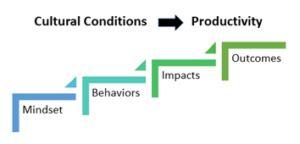2024 needs to be the year we uncover new ways of defining “productivity” to meet the workplace shifts at hand.
I was giving a keynote a couple months ago and veered from my planned agenda to discuss this very thing. The room was lit up with the importance of the need and this clear pathway I recommended.
There’s an old marketing joke that leaders know half their marketing works, but they don’t know which half. Pre-pandemic leaders might have said the same about the productivity of their workforce.
Our guts tell us that having people in the office, working hard and rowing together is “productive.” But this gut feeling assumes that when they’re together they’re motivated, happy and efficient.
Obviously, that’s not necessarily so. And today’s flexible workplace options necessitate a new level of clarity and relevance to properly direct, motivate and manage our people.
“Because I said so” is not a valid response to employees who believe they’d be more valuable in a different location or schedule. Vague calls for collaboration and productivity are frustrating and counterproductive.
The key for leaders: Give employees clarity on what “productivity” is for them, and then give them the motivation and environment to want to achieve it.
I’m visual, so here’s how I see it: we have to define our visions from the right to left and implement change from left to right.
Defining questions to ponder:
- Outcomes: What specific outcomes does the company and its departments need this year? Revenue targets, competitive advantage, cost reductions, valuation goals… ?
- Impacts: What specific actions and deliverables will enable those outcomes? Superior customer care, new ideas, breakthrough campaigns, fewer errors, faster speeds… ?
- Behaviors: What daily approaches will facilitate these impacts? THIS is what we mean when we “feel” that they’ll work more collaboratively or build esprit de corps in person, but we need to look closely. Do we need them to work in alignment on the goals, energetically manage workloads, break old bad habits, identify and solve friction, minimize distractions, meet faster turnaround times… ?
- Cultural Mindset: What beliefs and feelings need to be in place to trigger those behaviors? What needs to be changed or rewarded? A sense of purpose to achieve the greater goal, trust in fellow team members, personal growth, motivating recognition …?
After this process, the company’s needs are clearer and more actionable at the individual level. Choosing and explaining work location and schedule decisions are in a relevant context, and therefore, more motivating. And perhaps most importantly, leaders will be able to measure productivity and reward the employees who are delivering, wherever they are.
Here’s to Productivity v.2024. Because “because I said so” is not working.




